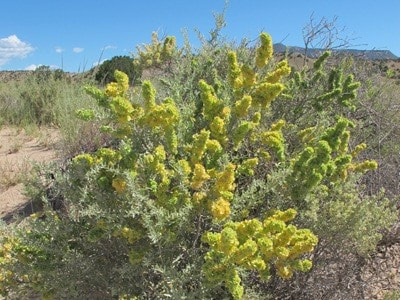|
Found in piñon-juniper woodlands
Seen blooming in April on the Espinosa Trail, Abiquiu The first bloom of this season is tiny and greenish so not easy to see. Mistletoe is a parasite of Junipers. It grows in 8 to 14 inch balls and looks very similar to the juniper leaves with smooth, branched, yellow-green stems. The leaves are tiny and scale-like. The female flowers are followed by small, round white to light pink berries. It has been used traditionally to make a tea to treat stomach problems and as “bad medicine for wizards”, the berries were used as a famine food, the branches were used to make a textile dye and for treating warts, and an infusion of the plant was used as a childbirth aid. Source. If you trying to identify a different flower then you can check what other flower bloom this month. If you cannot identify a flower from the website send a photo and where you took it to contact@rockymountainsflora.com. Read online for tips.
0 Comments
Found in sandy, gravelly, disturbed areas, roadsides
Seen in October at Plaza Blanca The last plant for this season is not in bloom, although a quick glance may give the impression of long clusters of petals. Fourwing Saltbush is a common shrub in our area growing to 5 feet wide and 5 feet high. Tiny greenish-white male and yellow female flowers are on separate plants which bloom in the spring. Leaves are narrow and grayish-green. What appears to be petals are small seeds with four broad wings. Initially green, they turn yellow, then tan and papery and remain on the plant into the winter providing browse for livestock and deer, and seeds for birds and rodents. Traditionally it has many practical and ceremonial uses. Leaves have a very acceptable taste with a salty tang and can be eaten cooked or raw. Seeds ground into a powder can be mixed with cereals and used in making cakes etc. The leaves and stems were burnt by the Hopi Indians and the alkaline ash used to maintain the blue color when cooking blue corn and as a substitute for baking soda. The Havasupai made a soapy lather from the leaves and used it as a wash on itches and rashes such as chickenpox, and for washing hair. The Navajo applied a poultice of the crushed leaves to ant bites to reduce the pain and swelling. A yellow dye is obtained from the leaves and stems, and the wood used to make arrow points. Source. If you are trying to identify a different flower then you can check what other flowers bloom this month. If you cannot identify a flower from the website send a photo and where you took it to contact@rockymountainsflora.com. Read online for tips. Found in sandy, disturbed areas, roadsides, under old junipers
Seen blooming in October at Abiquiu Lake Showy Four O'Clock is a magnificent native wildflower that blooms all summer and into the fall. The Latin name, Mirabilis multiflora, translates to "marvelous multi-flowered plant", which is a fitting description. Stems spread to 2 feet tall and 6 feet across forming a mound of soft, heart-shaped leaves and flowers. Flowers are funnel-like, up to 3" long, opening in the evening (photo taken at 6pm) and withering the next day, unless it is cloudy. The root is used in the treatment of stomach complaints; to relieve hunger and after overeating to relieve the discomfort. A poultice of the powdered root can be applied to swellings. The root was chewed by native North American medicine men to induce visions whilst making a diagnosis. Source. If you are trying to identify a different flower then you can check what other flowers bloom this month. If you cannot identify a flower from the website send a photo and where you took it to contact@rockymountainsflora.com. Read online for tips. Found in moist, disturbed areas, ditches
Seen blooming in October near the Rio Chama Devil’s Beggarticks grow to 3 feet tall with reddish branches and simple toothed leaves. Flower heads have long, leafy bracts, yellowish disk flowers and no ray flowers. The seeds have two prominent horns giving it the devilish common names and allowing it to stick to clothes and fur. The root of this plant has been used to make a tincture used for treating irritations, inflammations, pain, bleeding of the urinary tract and other uses. Source. If you are trying to identify a different flower then you can check what other flowers bloom this month. If you cannot identify a flower from the website send a photo and where you took it to contact@rockymountainsflora.com. Read online for tips. |
AuthorI am Marilyn Phillips, a native of England, whose love of nature and the outdoors from childhood brought me by a circuitous route to Crested Butte, Colorado in 1993 and 16 years later to northern New Mexico. My exploration of the many trails in these areas, my interest in wildflowers and photography, and career in computer system design came together in this creation. If you have any corrections, comments or questions, please contact me by email. Archives
September 2024
Categoriescopyright © 2020
|






 RSS Feed
RSS Feed